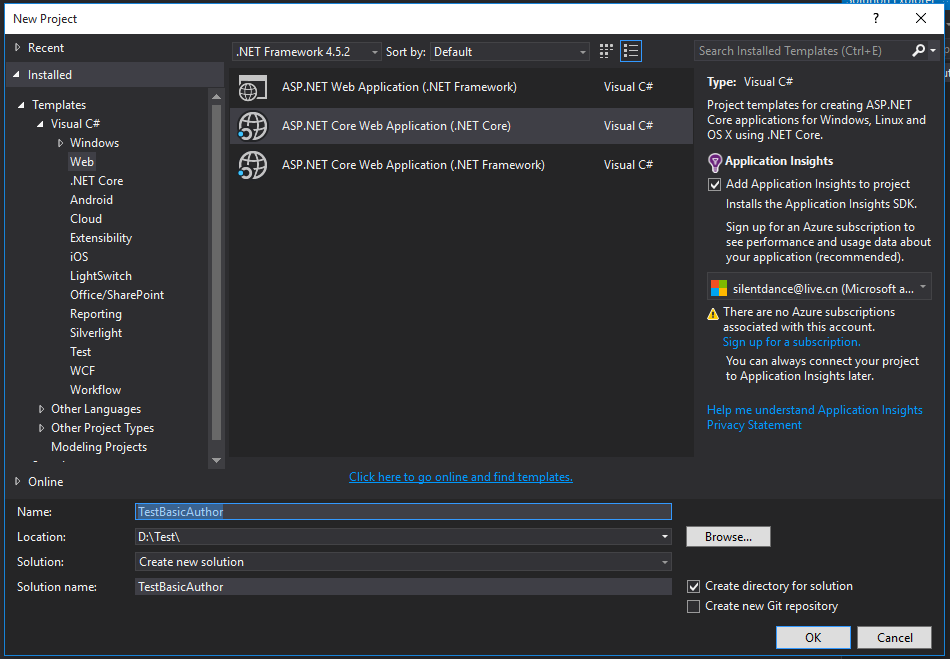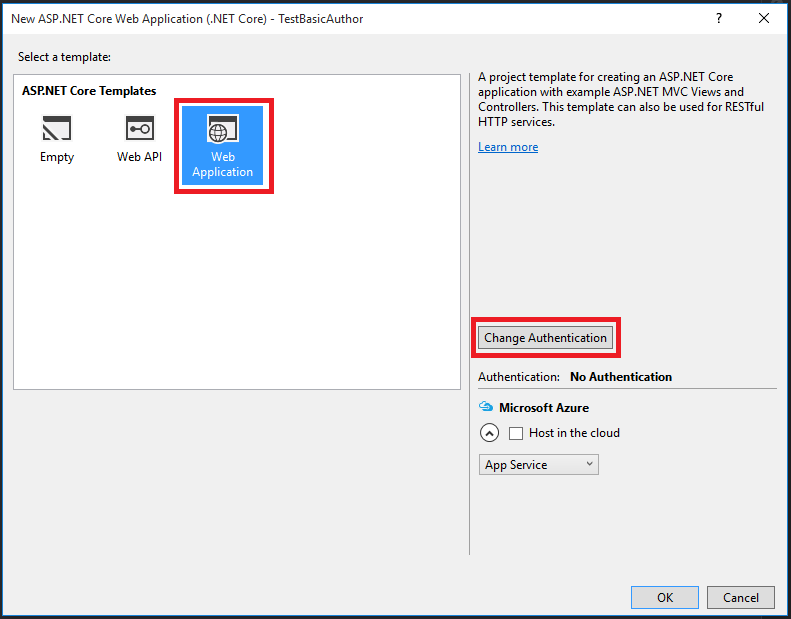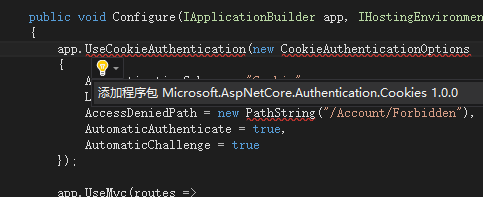ASP.NET終於可以跨平台了,但是不是我們常用的ASP.NET, 而是叫一個ASP.NET Core的新平台,他可以跨Windows, Linux, OS X等平台來部署你的web應用程序,你可以理解為,這個框架就是ASP.NET的下一個版本,相對於傳統ASP.NET程序,它還是有一些不同的地方的,比如很多類庫在這兩個平台之間是不通用的。
今天首先我們在ASP.NET Core中來實現一個基礎的身份認證,既登陸功能。
前期准備:
1.推薦使用 VS 2015 Update3 作為你的IDE,下載地址:http://www.bkjia.com/softjc/446184.html
2.你需要安裝.NET Core的運行環境以及開發工具,這裡提供VS版:http://www.bkjia.com/softs/472362.html
創建項目:
在VS中新建項目,項目類型選擇ASP.NET Core Web Application (.NET Core), 輸入項目名稱為TestBasicAuthor。

接下來選擇 Web Application, 右側身份認證選擇:No Authentication

打開Startup.cs
在ConfigureServices方法中加入如下代碼:
services.AddAuthorization();
在Configure方法中加入如下代碼:
app.UseCookieAuthentication(new CookieAuthenticationOptions
{
AuthenticationScheme = "Cookie",
LoginPath = new PathString("/Account/Login"),
AccessDeniedPath = new PathString("/Account/Forbidden"),
AutomaticAuthenticate = true,
AutomaticChallenge = true
});
完整的代碼應該是這樣:
public void ConfigureServices(IServiceCollection services)
{
services.AddMvc();
services.AddAuthorization();
}
public void Configure(IApplicationBuilder app, IHostingEnvironment env, ILoggerFactory loggerFactory)
{
app.UseCookieAuthentication(new CookieAuthenticationOptions
{
AuthenticationScheme = "Cookie",
LoginPath = new PathString("/Account/Login"),
AccessDeniedPath = new PathString("/Account/Forbidden"),
AutomaticAuthenticate = true,
AutomaticChallenge = true
});
app.UseMvc(routes =>
{
routes.MapRoute(
name: "default",
template: "{controller=Home}/{action=Index}/{id?}");
});
}
你或許會發現貼進去的代碼是報錯的,這是因為還沒有引入對應的包,進入報錯的這一行,點擊燈泡,加載對應的包就可以了。

在項目下創建一個文件夾命名為Model,並向裡面添加一個類User.cs
代碼應該是這樣
public class User
{
public string UserName { get; set; }
public string Password { get; set; }
}
創建一個控制器,取名為:AccountController.cs
在類中貼入如下代碼:
[HttpGet]
public IActionResult Login()
{
return View();
}
[HttpPost]
public async Task<IActionResult> Login(User userFromFore)
{
var userFromStorage = TestUserStorage.UserList
.FirstOrDefault(m => m.UserName == userFromFore.UserName && m.Password == userFromFore.Password);
if (userFromStorage != null)
{
//you can add all of ClaimTypes in this collection
var claims = new List<Claim>()
{
new Claim(ClaimTypes.Name,userFromStorage.UserName)
//,new Claim(ClaimTypes.Email,"[email protected]")
};
//init the identity instances
var userPrincipal = new ClaimsPrincipal(new ClaimsIdentity(claims, "SuperSecureLogin"));
//signin
await HttpContext.Authentication.SignInAsync("Cookie", userPrincipal, new AuthenticationProperties
{
ExpiresUtc = DateTime.UtcNow.AddMinutes(20),
IsPersistent = false,
AllowRefresh = false
});
return RedirectToAction("Index", "Home");
}
else
{
ViewBag.ErrMsg = "UserName or Password is invalid";
return View();
}
}
public async Task<IActionResult> Logout()
{
await HttpContext.Authentication.SignOutAsync("Cookie");
return RedirectToAction("Index", "Home");
}
相同的文件裡讓我們來添加一個模擬用戶存儲的類
//for simple, I'm not using the database to store the user data, just using a static class to replace it.
public static class TestUserStorage
{
public static List<User> UserList { get; set; } = new List<User>() {
new User { UserName = "User1",Password = "112233"}
};
}
接下來修復好各種引用錯誤。
完整的代碼應該是這樣
using System;
using System.Collections.Generic;
using System.Linq;
using System.Threading.Tasks;
using Microsoft.AspNetCore.Mvc;
using TestBasicAuthor.Model;
using System.Security.Claims;
using Microsoft.AspNetCore.Http.Authentication;
// For more information on enabling MVC for empty projects, visit http://go.microsoft.com/fwlink/?LinkID=397860
namespace TestBasicAuthor.Controllers
{
public class AccountController : Controller
{
[HttpGet]
public IActionResult Login()
{
return View();
}
[HttpPost]
public async Task<IActionResult> Login(User userFromFore)
{
var userFromStorage = TestUserStorage.UserList
.FirstOrDefault(m => m.UserName == userFromFore.UserName && m.Password == userFromFore.Password);
if (userFromStorage != null)
{
//you can add all of ClaimTypes in this collection
var claims = new List<Claim>()
{
new Claim(ClaimTypes.Name,userFromStorage.UserName)
//,new Claim(ClaimTypes.Email,"[email protected]")
};
//init the identity instances
var userPrincipal = new ClaimsPrincipal(new ClaimsIdentity(claims, "SuperSecureLogin"));
//signin
await HttpContext.Authentication.SignInAsync("Cookie", userPrincipal, new AuthenticationProperties
{
ExpiresUtc = DateTime.UtcNow.AddMinutes(20),
IsPersistent = false,
AllowRefresh = false
});
return RedirectToAction("Index", "Home");
}
else
{
ViewBag.ErrMsg = "UserName or Password is invalid";
return View();
}
}
public async Task<IActionResult> Logout()
{
await HttpContext.Authentication.SignOutAsync("Cookie");
return RedirectToAction("Index", "Home");
}
}
//for simple, I'm not using the database to store the user data, just using a static class to replace it.
public static class TestUserStorage
{
public static List<User> UserList { get; set; } = new List<User>() {
new User { UserName = "User1",Password = "112233"}
};
}
}
在Views文件夾中創建一個Account文件夾,在Account文件夾中創建一個名位index.cshtml的View文件。
貼入如下代碼:
@model TestBasicAuthor.Model.User
<html xmlns="http://www.w3.org/1999/xhtml">
<head>
<title></title>
</head>
<body>
@using (Html.BeginForm())
{
<table>
<tr>
<td></td>
<td>@ViewBag.ErrMsg</td>
</tr>
<tr>
<td>UserName</td>
<td>@Html.TextBoxFor(m => m.UserName)</td>
</tr>
<tr>
<td>Password</td>
<td>@Html.PasswordFor(m => m.Password)</td>
</tr>
<tr>
<td></td>
<td><button>Login</button></td>
</tr>
</table>
}
</body>
</html>
打開HomeController.cs
添加一個Action, AuthPage.
[Authorize]
[HttpGet]
public IActionResult AuthPage()
{
return View();
}
在Views/Home下添加一個視圖,名為AuthPage.cshtml
<html xmlns="http://www.w3.org/1999/xhtml"> <head> <title></title> </head> <body> <h1>Auth page</h1> <p>if you are not authorized, you can't visit this page.</p> </body> </html>
到此,一個基礎的身份認證就完成了,核心登陸方法如下:
await HttpContext.Authentication.SignInAsync("Cookie", userPrincipal, new AuthenticationProperties
{
ExpiresUtc = DateTime.UtcNow.AddMinutes(20),
IsPersistent = false,
AllowRefresh = false
});
啟用驗證如下:
public void Configure(IApplicationBuilder app, IHostingEnvironment env, ILoggerFactory loggerFactory)
{
app.UseCookieAuthentication(new CookieAuthenticationOptions
{
AuthenticationScheme = "Cookie",
LoginPath = new PathString("/Account/Login"),
AccessDeniedPath = new PathString("/Account/Forbidden"),
AutomaticAuthenticate = true,
AutomaticChallenge = true
});
}
在某個Controller或Action添加[Author],即可配置位需要登陸驗證的頁面。
以上就是本文的全部內容,希望對大家的學習有所幫助,也希望大家多多支持幫客之家。